Hardware
How To Lubricate Door Hinges
Before you start lubricating door hinges, you want to have an old rag handy. Be careful with how much spray or grease you apply. You don't need a lot. More is not better in this situation. Wipe up any excess with the rag quickly before it runs and gets on something.
For related topics, see the articles 'Door Hinge Repairs', 'Replacing Door Hinges', 'Adjusting Door Hinges' and 'How To Fix a Door'.
It is best to remove the pin to lubricate a door hinge. You can use a small screwdriver and a hammer to tap the pin out, usually from the bottom of the hinge. Keep the door closed and do one hinge at a time. This way the door will stay supported.
Spray a little silicone spray on the joints in the two hinge leaves where they rub together. Spray a coating onto the pin and tap it back into the hinge. Add a little more spray when you are about half way. Finish tapping the pin into place. Your squeaky door hinge should soon be history.
Repeat this process for the other hinges on the door. The procedure with grease is similar. Coat the pin with a thin layer of grease. Put a small dab of grease on the end and tap the pin back into place.
After you have taken care of all the hinges, open the door. Move it back and forth several times to work the lubricant in. Hopefully, the squeak is gone. Repeat the process if the squeak persists. You want to be sparing with the lubricant, but not too sparing.
Oiling Door Hinges
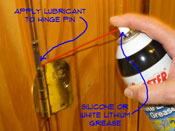 The simplest fix for this problem is oiling door hinges. This is a fairly simple task. The only material you need is five dollar (or less) can of silicone spray. There are a few things to concern yourself with. The first is the potential mess. The other is the lubricant that you decide on.
The simplest fix for this problem is oiling door hinges. This is a fairly simple task. The only material you need is five dollar (or less) can of silicone spray. There are a few things to concern yourself with. The first is the potential mess. The other is the lubricant that you decide on.
Graphite is often recommended for door hardware. It is dry and will not get your keys all oily. In moderation, graphite is a great product and will free up sticky locks. For hinges there are some concerns. The black dry powder can get on surfaces like painted walls and carpet and stain them. This could be a real problem. The hinge works, but the carpet is ruined.
For oiling door hinges, silicone spray or white lithium grease is probably the best choice. Silicone is the easiest, but does not last as long as the grease. When use properly, the mess is minimal. If you decide to use graphite, be careful.
Remove the hinge pins from the hinge one at a time. Apply the lubricant and put the pin back in. When the hinges are lubricated, you should work the door back and forth to work the lubricant in. Repeat if the squeaks or stiffness is persistent. For more information see the articles, 'Squeaky Door Hinges' and 'Fixing Rusty Hinges', for more information on hinge lubrication issues.
WARNING!! Only Remove One Hinge at a Time. The Door Will Fall!!! WARNING!!!
Lubricating a Rusty Hinge
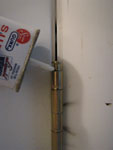 Lubricating a rusty hinge is a good choice when the hinge is still working. Oil will loosen it and quiet it down with a little effort.
Lubricating a rusty hinge is a good choice when the hinge is still working. Oil will loosen it and quiet it down with a little effort.
When a rusty hinge has deep rust, you may want to start by soaking the hinge with penetrating oil. Use a good quality penetrating oil. Apply the oil liberally, without getting it everywhere. Keep a rag handy to wipe up any excess. Allow the oil to soak in before you try working the hinge. You may want to repeat this step a few times with a badly damaged hinge.
After the penetrating oil has freed up the hinge, you can lubricate it. Use a silicone spray or white lithium grease for this task. Keep in mind that an old badly rusted hinge may need repeated treatments.
Lubricating a rusty hinge is easier when you remove the pin. Not all pins are removable, especially on older doors. When this happens, use spray silicone or spray penetrating oil and try to get it in every crevice of the hinge. Work the door back and forth to work the lubricant down into the hinge.
The age and appearance of the rusty hinge may make you decide to replace it. The easiest replacement job is when you have new hinges that are the same size as the old ones. You can replace one hinge at time without taking the door off. Unfortunately, finding replacements for older hinges is difficult. You may need to go online or go to a specialty hardware store. Cost will go up for hinges that are restoration quality.
One other option would be to fit the door for a newer style hinge. This will require some carpentry skills and may be beyond the ability of the average homeowner. You need to take the door off and change the mortises in the door and frame.
Summary
For related topics, see the articles 'Door Hinge Repairs', 'Replacing Door Hinges', 'Adjusting Door Hinges' and 'How To Fix a Door'.
Purchasing Door Hinge Lubricant
A lot of people recommend graphite for squeaky door hinges. Does graphite work? Yes it does, it will stop the squeak. The drawback is that graphite is a black powder and it can make quite a mess if it gets on something like your carpet or painted walls. Graphite can work its way out of the hinge and stain things. So for door hinges, I do not recommend graphite.
Not sure if this is the right problem? See the articles 'Troubleshooting Door Problems' and 'Fixing Door Hinges' for more information.
The two best choices are a silicone spray or white lithium grease. My preference it the silicone spray. It is colorless and can be used sparingly. You may have to use it more often than grease, but it is less messy and a little easier to use. Purchase a spray can of silicone spray, one that is suitable for door hardware. It should have one of those long red tubes taped to the side of the can.
You can also use white lithium grease. You will have to take the pin out of the hinge to use it. You will also have to watch for excess seeping out of the hinge for a couple of days. Other things like three in one oil and machine oil will also work. Caution needs to be exercised when using oils, don't use to much.
How To Fix Squeaky Door Hinges
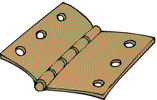 Squeaky door hinges are right up there with dripping faucets on the irritation scale. The squeak develops over time until you can't stand it and something needs to be done. Dealing with a noisy hinge should be an easy thing to fix. Some suitable lubricant is all you need.
Squeaky door hinges are right up there with dripping faucets on the irritation scale. The squeak develops over time until you can't stand it and something needs to be done. Dealing with a noisy hinge should be an easy thing to fix. Some suitable lubricant is all you need.
For related information see 'Troubleshooting Door Problems', 'Repairing Door Hinges', 'Adjusting Interior Doors' and 'How To Adjust Exterior Doors'.
Door hinges are a moving part. They are made of two pieces of flat metal that have notched tabs of metal. These tabs interlock with the tabs on the other side of the hinge and are wrapped around a pin that hold them together. When the door opens and closes, the plates rub against each other and against the pin. When the grease or graphite wears away you will get metal rubbing against metal. That's when the squeaks start.
There is no point in putting off this repair. It should only take a few minutes. In five minutes or less you can quit cringing every time someone opens the door.
Fixing Squeaky Door Hinges - Information
What Can You Save?
A service man will likely charge you $50 to $75 to take care of this problem. This is mostly due to the fact that he has to spend time driving there.
How Hard Could It Be?
Fixing squeaky door hinges is pretty simple and does not take much effort.
Check the Simple Things!
This is already the simplest repair you can make with a door hinge. There is not simpler task to perform.
What Can Go Wrong?
Getting oil all over the door and wall is probably the biggest problem you will face. Use the lubricant sparingly. Always keep a rag handy when you are using oil and other lubricants.
Tight Squeaking Door Hinges
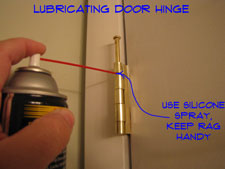 Tight squeaking door hinges are pretty aggravating. Most of the time, you can fix them with a little oil.
Tight squeaking door hinges are pretty aggravating. Most of the time, you can fix them with a little oil.
Try lubricating the hinges first. Use a recommended silicone spray, oil or grease made for this purpose. You can use a punch and a hammer to drive the pin out, (usually from the bottom of the hinge up, unless it was installed upside down). For doors with only two hinges, leave the pins in about halfway. Keep a rag handy and apply the lubricant sparingly, but in enough quantity to solve the problem. Watch for drips and oozing. Replace the pin and open and close the door several times, working the lubricant in.
Are the hinges rusted or painted beyond what a little silicone spray can take care of? Replacing them is easy if you get the same size. A door with only two hinges will need to be taken off before the hinges can be changed. Open the door and put something under the bottom to support it (a block of wood, book, not your toe). Unscrew the bottom hinge first and then the top. Hang onto the door when you release the last screw. For solid core or wood doors you may want to get some help when you take the door off. Lean the door against the wall and finish removing the hinges.
Obtain enough replacement hinges for the door, usually three. Change them one at a time. You may need a chisel or knife to get them loose if they have been painted in place over time. Replacing the hinges, even if you do them one at a time, is repairing a prehung interior door. Well done!
Loosening Tight Door Hinges
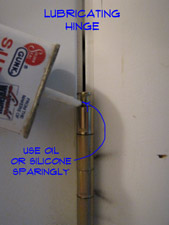 Before you consider replacing the hinges, try loosening tight door hinges with lubricant. Use a recommended silicone spray, oil or grease made for this purpose. You can use a punch and a hammer to drive the pin out, (usually from the bottom of the hinge up, unless it was installed upside down).
Before you consider replacing the hinges, try loosening tight door hinges with lubricant. Use a recommended silicone spray, oil or grease made for this purpose. You can use a punch and a hammer to drive the pin out, (usually from the bottom of the hinge up, unless it was installed upside down).
Keep a rag handy and apply the lubricant sparingly, but in enough quantity to solve the problem. Watch for drips and oozing. Replace the pin and open and close the door several times, working the lubricant in.
One or all of the hinges could need attention. Only take one pin out at a time. Taking out two or three will cause the door to fall and possibly damage it. Only take all the pins out when you are prepared to remove the door. Loosening tight door hinges by lubricating the pins may be a maintenance item that needs to be repeated periodically.
Are the hinges rusted or painted beyond what a little silicone spray can take care of? Replacing them is easy if you get the same size. Remove the middle hinge and take it with you to match up at the hardware store. Obtain enough replacement hinges for the door, usually three.
Change them one at a time. You may need a chisel or knife to get them loose if they have been painted in place over time. Replacing the hinges, even if you do them one at a time qualifies as a successful entry door repair.
Troubleshooting Squeaking Door Hinges
In Step One the article 'Purchasing Door Hinge Lubricant', helped you to make sure that you get the right oil or grease for your door hinges. Most home supply or hardware stores have what you need.
'Lubricating Door Hinges' is the article that covers the actual oiling of the door hinges. It is a pretty easy job, when you set aside the mess.
Sometimes the door is out of adjustment and causing the door to bind. When this happens, oil alone may not solve the problem. See the article 'How To Adjust Door Hinges' for information and instructions on this repair.
Summary
Fixing a squeaky door hinge should not have been too much trouble for you. You have to take the pins out to apply the lubricant. You put them back in and that should take care of the problem. Is your door quiet now? Good, you are done with this project.
If you are a homeowner you have other projects you need to attend to. Since this one was so easy you are probably inspired to attempt something else.
Fixing a Rusty Hinge
 What can you do with a rusty hinge? This is a real problem for door hinges. Your door may not open or open with difficulty. The door will be noisy when it operates.
What can you do with a rusty hinge? This is a real problem for door hinges. Your door may not open or open with difficulty. The door will be noisy when it operates.
Rust is usually found on hinges that are old and perhaps of poor quality material. What are the options? Is it something you can take care of? Salvaging the hinge is possible, replacing it is another option. Both of options are within reach, for a homeowner.
Not sure if this is your problem? See the article 'How To Fix a Door' for a complete listing of all the door topics.
Hinges in days gone by were made of iron and low grade steel. Rust was a common problem. Oil or grease would be the common solution for battling the rust. The hinges would still disintegrate over time and eventually quit working. Since then better methods and better materials have changed hinges. Quality door hinges are made of brass or metal alloys that don't rust. Poor quality hinges may only have a protective coating on them the breaks down over time, then rust can appear.
This leaves you with two basic options. You can try to lubricate a rusty hinge and get it working again. This does not help much with the appearance. The other option would be to replace the hinge with a new one. This will help the door to work smoothly and the door will look nicer.
Fixing a Rusty Hinge - Information
What Can You Save?
There is a range of cost here for a normal door. Lubricating and freeing up the hinges or replacing them with a set that is the same size could run from $50 to $100. Taking an older door down and modifying it for a new set of hinges could run from $100 to $200.
How Hard Could It Be?
Fixing rusty hinges could involve some work if the door is old and the hinge style is no longer available. Lubricating hinges to get the working is not hard.
Check the Simple Things!
Lubrication is the quick solution for a rusted hinge. You may need to start with penetrating oil and then move up to silicone spray or white lithium grease.
What Can Go Wrong?
Old hinges may be of a style and size that is no longer available or only available from specialty hardware sources. Fitting newer hinges onto an old door can involve some work. Lubricating a stiff rusty hinge can involve a lot of oil. Oil makes a mess, so make sure you have rags handy to clean up the excess.
Troubleshooting a Rusty Hinge
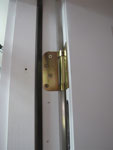 Troubleshooting rusty door hinges is the first step you should take in deciding what to do with a tight squeaking door. First determine if the hinge is still serviceable.
Troubleshooting rusty door hinges is the first step you should take in deciding what to do with a tight squeaking door. First determine if the hinge is still serviceable.
When you have a rusted hinge, you first need to determine how badly the metal is damaged. Surface rust will make the hinge look bad, but it should still work. Deep rust may have deteriorated the metal to the point where it is ready to break. It may be broken already. You don't want the hinge to break and the door fall off and hurt someone.
Visually inspect the hinge and try to determine the level of rust. Does the door work, can you open it? Do the hinges appear to be functional? Do large flakes of rust fall off when you move the door? These are some question you might consider when checking the hinges.
For surface rust you are safe to lubricate the hinge and start using the door. Lubrication will not fix the appearance issues. Some soap and a scrub brush or steel wool could help with the appearance. See the article 'Lubricating Rusty Hinges' for more information. Replacing the hinges is still a consideration if they look too bad.
WARNING!! Get Help When You Remove a Door, They Are HEAVY!!! WARNING!!!
Lubricating Rusty Hinges
See 'How To Lubricate a Door Hinge'
Cleaning Up Door Hinges
Cleaning up door hinges is the last step in fixing your squeaky hinges. The oil can continue to ooze out for a while, so cleaning up is a must.
Keeping a rag handy while you are oiling the door hinges will save the amount of cleaning up the door hinges you have to do. Careful use of the oil or grease is also important. Putting too much on the pin will cause it to ooze out and run down the door.
After you have move the door back and forth several times, you can check for any excess lubricant. Use the rag to wipe any residue off. It is a good idea to do a couple of checks over the next few days. Wipe off any excess lubricant the works out of the cracks in the hinge. Once the mess is cleaned up, you are done with this squeaky door hinge project.
Summary
How did it go with your rusty hinge? Were you able lubricate them and clean them up. That is good news. Were they too far gone or did they look too bad for this procedure? Did you decide to replace them? Hopefully, you found hinges to match and the replacement was not difficult.
Worst case you had to fit new hinges to an old door. This can be done, although it involves using a chisel and some lay out. Now that your rusty hinge issues are behind you, what are you going to do? You probably have other home repair projects on your list. Keep at it, there is an afternoon off somewhere on the horizon.
How To Fix a Door Knob
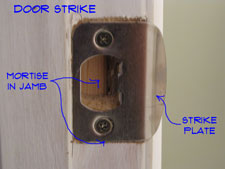 A strike plate that is mis-aligned can cause the door not to lock or close properly. Adjusting it can help.
A strike plate that is mis-aligned can cause the door not to lock or close properly. Adjusting it can help.
Not your problem? See 'Door Repair' for a complete listing of door topics. Door locks are discussed in depth in the article 'Door Lock Repair'. Use this link to get to that series of articles.
Fixing door locks and strikes are the main hardware issues for an interior door. Door locks need to align properly with the strike plates on the frame. Even a minor deviation can cause the door not to work.
The strike plates on the lock set can cause the door to bind. There are three ways that the strike plate can cause problems. (1) A door that is sagging will not allow the lock to properly align with the strike plate. When this is your problem you need to adjust the door. See the article 'Adjusting Interior Doors', for more information.
(2) The strike plate needs to be the proper distance from the door stop. A strike plate that is not close enough to the stop will leave the door loose in the opening. On the other hand, when the strike plate is too close the lock won't catch and the door won't stay closed. (3) The third problem is when the strike plate is binding against the door itself. This happens when the plate is not recessed into the frame.
Based on the above information, determine whether your door is too loose or if the latch isn't catching. When you have determined which way the strike plate needs to go you can move it. Measure the distance from the face of the door to the flat portion of the door lock tongue. See if the distance is different between the door stop and the flat section of the strike plate.
You can remove the strike plate and use a chisel to remove some wood from the mortise. The plate should be flush with the jamb and not protrude out. Strike plates should not be fastened on top of the jamb. They should be recessed in. Use a pencil to draw an outline around the strike plate. Remove it and use a chisel to cut out the wood to recess it.


